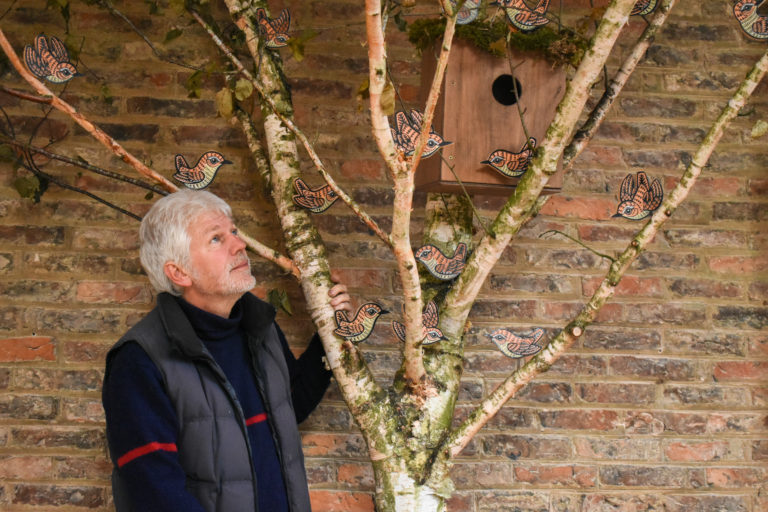
YORK linocut artist Gerard Hobson is exhibiting for the first time at Beningbrough Hall, Beningbrough, near York.
His Winter Wildlife In Print show at the National Trust property combines prints for sale in the Hayloft gallery with 14 sculptural scenes in the outbuildings, gardens, grounds and parkland, inspired by creatures that make Beningbrough their winter home.
Throughout winter until March 1, they can be seen only on Saturdays and Sundays, from 11am to 3.30pm, and additionally during the February half term.
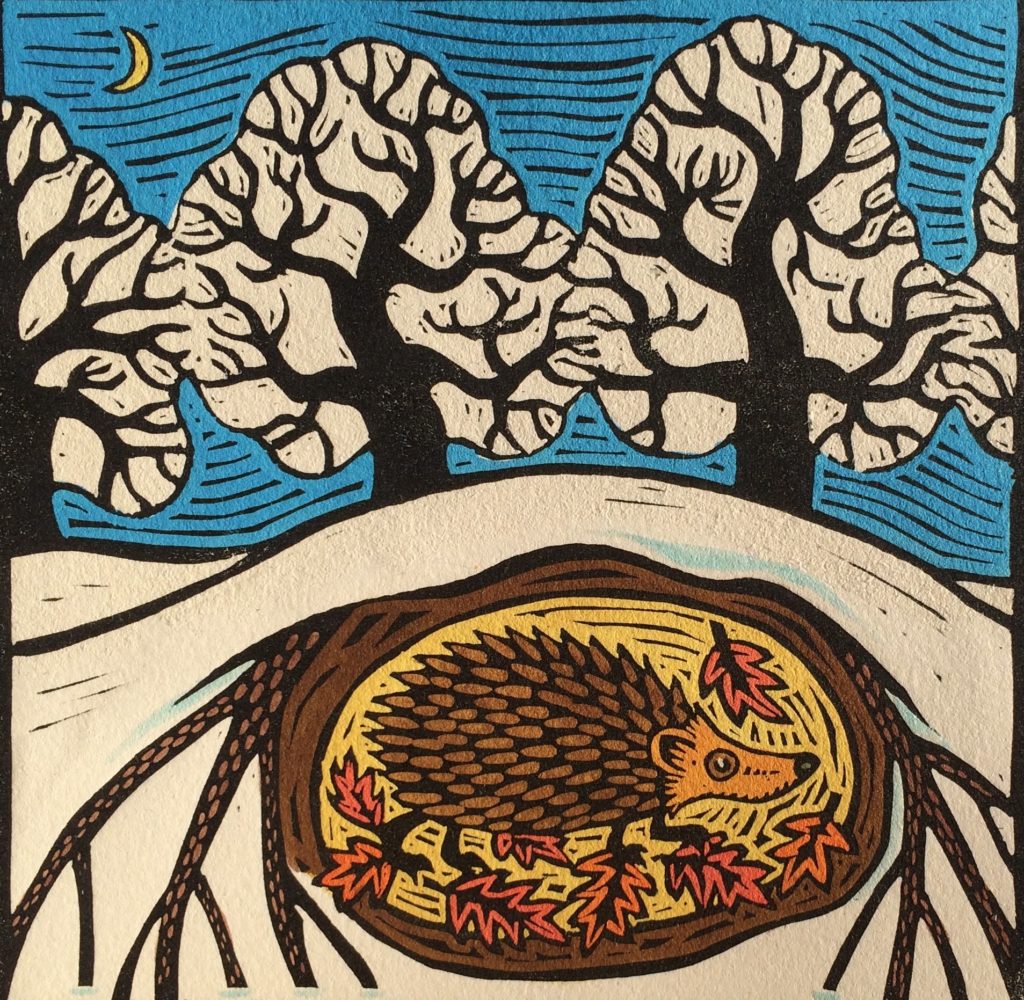
Created out of linoprints, cut out and mounted to make Hobson’s 3D installations, birds are swooping, climbing or nesting among the trees, from owls and robins to cuckoos, wrens and swifts.
Eyes should be kept peeled for the naughty magpies with their stolen ring. Do look out, too, beyond the ha-ha to the parkland to spot a pair of boxing hares, better seen close-up should anyone be carrying binoculars.
Bang goes the common knowledge, by the way, that boxing hares are a brace of males scrapping over a female. Apparently, as a sign reveals, the fights involve a male and a female, not welcoming his persistent attention. Who knew, the lady hares are effectively saying “Do one” or “Get yourself a better chat-up line”!
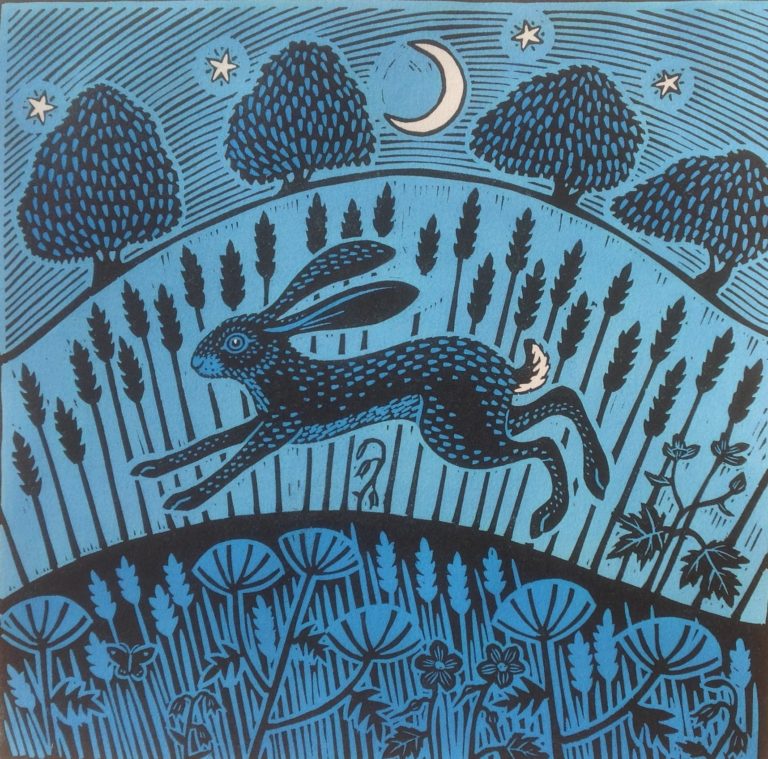
These outdoor installations are the first time Gerard Hobson has used his work in this way, and in creating the exhibition, he has made many new pieces especially for the Beningbrough garden.
Not only birds, but other animals too make an appearance in unexpected places, searching for food and preparing to hibernate or sleep, whether bats, mice, stoats or a hedgehog.
Make sure to head upstairs in the stables to the Hayloft for an indoor exhibition showcasing more of Gerard’s printed work, all for sale. Visitors also can create a feeder in the bothy and pick up one of the special colouring-in sheets in the walled garden restaurant, while in the laurel den a dawn chorus soundscape is a reminder of warmer days to come.
Here Charles Hutchinson puts the questions on the art of the matter to artist Gerard Hobson.
You have a background as a zoologist and botanist. What draws you to depicting nature and wildlife, Gerard?
“One of my earliest recollections was collecting a set of bird cards given away with PG Tips tea (I would love to do a set for Yorkshire Tea).
“This moved on to sets of animals both native and around the world, which then grew into a love of nature.
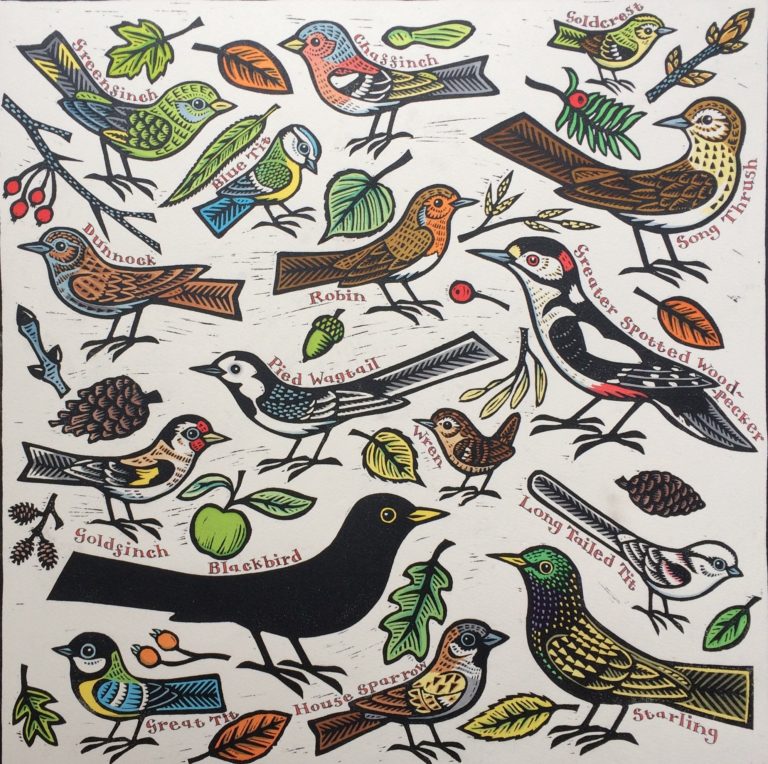
“At the age of about 16, I had a ten-minute chat with a careers adviser, who asked me what my interests were. I said ‘nature and art’ and he said ‘there’s no money in art, go down the science route’, hence the zoology.
“My first job after graduating was with the Wiltshire Wildlife Trust and this is where my knowledge of plants developed.”
In this age of climate change concern and the extinction of creatures, your art can make a powerful statement …but at the same time, in the short film shown in the Beningbrough Hall bothy, you talk of your art being fun. Discuss…
“People who buy my prints tell me they’re bright and cheerful and have a sense of fun about them. I’m pleased they get that response but I also hope that my images might create a greater interest in wildlife.
“I think most people are aware of the loss of habitat and species and the impact of global warming on our environment, but people feel the problem is so great that their small contribution isn’t going to make any difference.
“I hope my art may stir people to become more interested in the wildlife around them, to feed the birds and join their local wildlife trust. To share this with their children and their children’s children and hopefully generations of young people will become more interested in the birds and woodlands around them. Maybe some will go on to be environmental campaigners – who knows!”
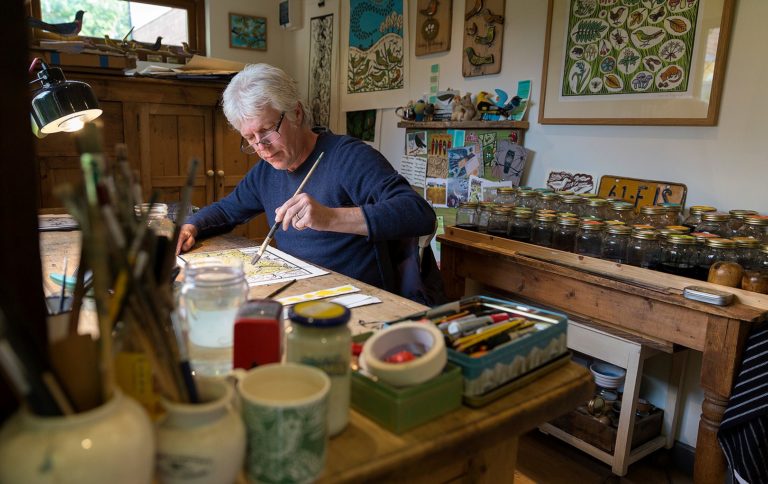
Your past work often has been of individual creatures. How did you come up with the idea of doing installations and sculptural scenes for the Beningbrough exhibition?
“When I was asked to do an exhibition at Beningbrough, they told me they wanted me to do something outdoors but they wanted me to use my linocuts. However, I knew this was going to create several problems.
“Life-size birds outside would just disappear into the great outdoors, so I had to do everything twice its normal size.
“I wanted the work to be original because somehow, once you reproduce art, it seems to lose its essence, but trying to make my paper linocuts waterproof also proved challenging.
“I felt each installation needed some sort of narrative. So, my vision for the exhibition was not just about the art but for each one to be linked with some related fact or folklore.”
How does the impact of a group of birds/hibernating animals/etc contrast with those past works?
“I think the outdoor display at Beningbrough challenged me artistically as I have never done an outside exhibition before and I wanted to come up with something a little bit different and quirky: a seek and find concept.
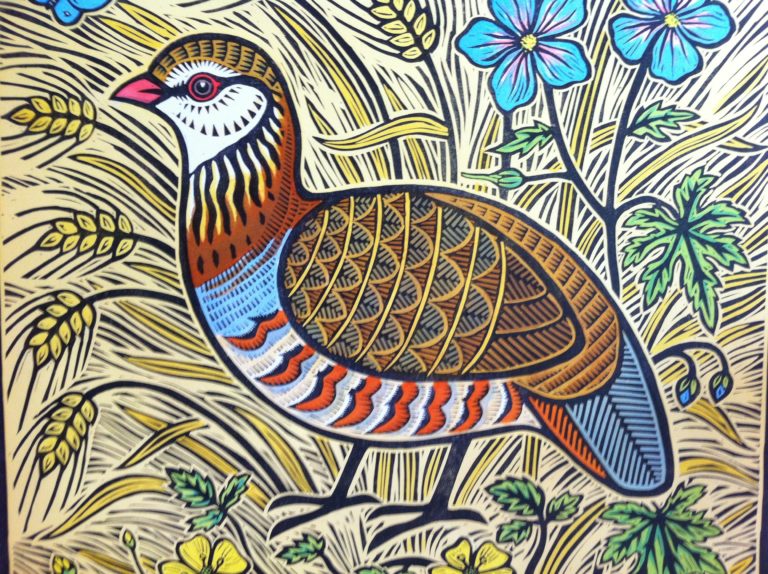
“As an artist you are looking at ways to develop, but not lose your style. Before the offer at Beningbrough came about, I’d been considering doing some framed images of my linocuts in naturalistic settings using fake plants, branches, mosses etc.
“When I was about 12, I started collecting taxidermy and had quite a large collection, but over the years it has become less fashionable. However, taxidermy still interests me as an art form, hence the thought of putting my linocuts in cases.”
What influence did the Beningbrough Hall outbuildings and grounds have on your work. Furthermore, did the task of creating work for the outdoors present different challenges?
“When I was asked to do the exhibition, the brief was very broad and they basically gave me carte blanche on the spaces around the grounds, which was fantastic!
“I obviously wanted to do something that was on a circuit so I around a few times, identifying my favourite trees and possible places to put things.
“Many of the themes for the installations came from the spaces themselves. The stumpery led to the creation of a group of mushrooms and the tool shed looked like a good setting to put animals and birds for sheltering away from the cold winter weather.”
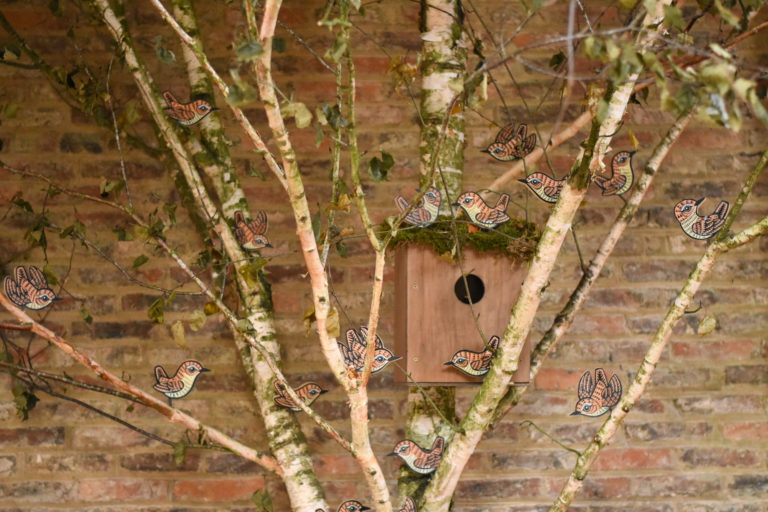
What impact did the winter season have on the work?
“The winter weather has created a few problems. When we were installing the exhibition, it seemed to be constantly raining, which made the installation a very cold and wet experience!
“Once the exhibition was up, we had a couple of weeks where various pieces were coming away from their metal dowel. (I’m not sure if it was the persistent rain or the wrong sort of glue being used.)
“Added to which, very high winds brought down the swallow installation twice and the boxing hares were blown over. There has also been a problem with the thrush installation being attacked by what we think is the resident jackdaw population! “However, through it all, the gardeners and volunteers at Beningbrough have been fantastic at helping put things right.”
What will happen to the installation pieces after the exhibition ends on March 1?
“Good question, no idea. Some of the pieces have weathered, which gives them a look of an old loved toy. I don’t think they’ll last outdoors permanently. I’m open to suggestions.”

What do you like most about linocuts as an artform?
“I went on a printmaking course at York College about ten years ago and I was particularly taken with producing linocuts.
“Carving away on lino has a very therapeutic feel to it, and it was through this medium that I developed my own style. Prior to this, I’d been quite good at art technically, but didn’t have a particular look to my art, so this technique seemed to release me into something I’d been trying to do for years.
“When you produce a piece of art, you can feel quite attached to it, and it can be quite difficult to part with. With a linocut, because it’s one of a limited edition, you can always hold one back for yourself or a loved one.”
What are you working on next? York Open Studios 2020 on April 18, 19, 25 and 26, perhaps?
“My exhibition in the Hayloft gallery at Beningbrough is running until the beginning of March, with the sales from this keeping me quite busy at the moment, and I want to keep refreshing this part of the show, so that returning visitors get to see something a little different each time.
“Also, I need to crack on with some new work for York Open Studios, which I’m very excited about this April.”
Gerard Hobson’s Winter Wildlife In Print exhibition and installations are on show at Beningbrough Hall, Beningbrough, near York, until March 1. To plan a visit, go to nationaltrust.org.uk/beningbrough for more information.
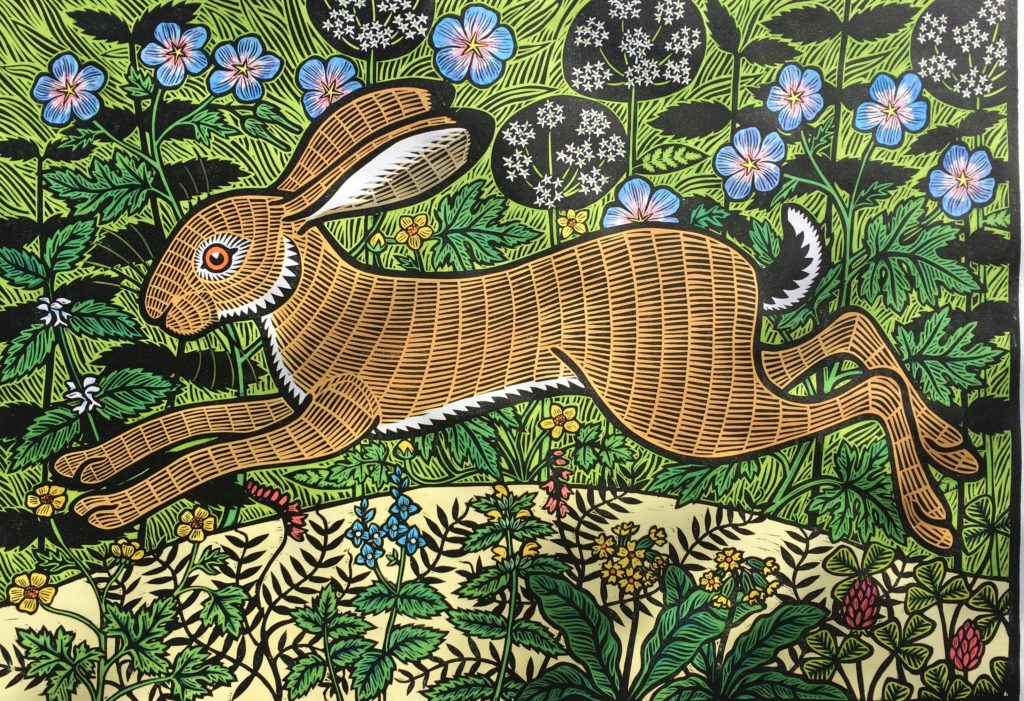
Did you know?
SINCE childhood, Gerard Hobson has had a love for birds, animals and art. His fascination with wildlife saw him qualify as a zoologist from Bangor University in 1984 and he then worked for a couple of years for Wiltshire Wildlife Trust as a botanist. Later he became an illustrator for the trust, working on leaflets and sign boards.
After relocating up north, Gerard worked for Yorkshire Wildlife and continued to develop his work on a freelance basis. In more recent years, he has turned his hand to woodcarving and these days focuses his attentions on print making, having studied the art form in York.
